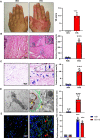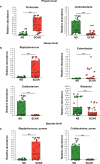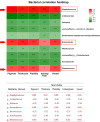Microbiome dysbiosis occurred in hypertrophic scars is dominated by S. aureus colonization
- PMID: 37701435
- PMCID: PMC10494536
- DOI: 10.3389/fimmu.2023.1227024
Microbiome dysbiosis occurred in hypertrophic scars is dominated by S. aureus colonization
Abstract
Background: The mechanisms of hypertrophic scar formation and its tissue inflammation remain unknown.
Methods: We collected 33 hypertrophic scar (HS) and 36 normal skin (NS) tissues, and detected the tissue inflammation and bacteria using HE staining, Gram staining, and transmission electronic microscopy (TEM), in situ hybridization and immunohistochemistry for MCP-1, TNF-α, IL-6 and IL-8. In addition, the samples were assayed by 16S rRNA sequencing to investigate the microbiota diversity in HS, and the correlation between the microbiota and the indices of Vancouver Scar Scale(VSS)score.
Results: HE staining showed that a dramatically increased number of inflammatory cells accumulated in HS compared with NS, and an enhanced number of bacteria colonies was found in HS by Gram staining, even individual bacteria could be clearly observed by TEM. In situ hybridization demonstrated that the bacteria and inflammation cells co-localized in the HS tissues, and immunohistochemistry indicated the expression of MCP-1, TNF-α, IL-6, and IL-8 were significantly upregulated in HS than that in NS. In addition, there was a significantly different microbiota composition between HS and NS. At the phylum level, Firmicutes was significantly higher in HS than NS. At the genus level, S. aureus was the dominant species, which was significantly higher in HS than NS, and was strongly correlated with VSS indices.
Conclusion: Microbiome dysbiosis, dominated by S. aureus, occurred in HS formation, which is correlated with chronic inflammation and scar formation, targeting the microbiome dysbiosis is perhaps a supplementary way for future scar management.
Keywords: S. aureus; Vancouver Scar Score; hypertrophic scar; inflammation; microbiome dysbiosis.
Copyright © 2023 Yu, Mao, Zhou, Yuan and Wang.
Conflict of interest statement
The authors declare that the research was conducted in the absence of any commercial or financial relationships that could be construed as a potential conflict of interest.
Figures




Similar articles
-
Bacteria in hypertrophic scars promote scar formation through HSBP1-mediated autophagy.Wound Repair Regen. 2025 Jan-Feb;33(1):e13253. doi: 10.1111/wrr.13253. Wound Repair Regen. 2025. PMID: 39823159 Free PMC article.
-
Prognostic tools for hypertrophic scar formation based on fundamental differences in systemic immunity.Exp Dermatol. 2021 Jan;30(1):169-178. doi: 10.1111/exd.14139. Epub 2020 Aug 17. Exp Dermatol. 2021. PMID: 32618380 Free PMC article.
-
The Role of Gut Microbiome in Psoriasis: Oral Administration of Staphylococcus aureus and Streptococcus danieliae Exacerbates Skin Inflammation of Imiquimod-Induced Psoriasis-Like Dermatitis.Int J Mol Sci. 2020 May 7;21(9):3303. doi: 10.3390/ijms21093303. Int J Mol Sci. 2020. PMID: 32392785 Free PMC article.
-
Skin microbiome dysbiosis and the role of Staphylococcus aureus in atopic dermatitis in adults and children: A narrative review.J Eur Acad Dermatol Venereol. 2023 Jun;37 Suppl 5:3-17. doi: 10.1111/jdv.19125. J Eur Acad Dermatol Venereol. 2023. PMID: 37232427 Review.
-
[Atopic eczema and microbiome].Hautarzt. 2019 Jun;70(6):407-415. doi: 10.1007/s00105-019-4424-6. Hautarzt. 2019. PMID: 31111169 Review. German.
Cited by
-
The role of macrophages in hypertrophic scarring: molecular to therapeutic insights.Front Immunol. 2025 Mar 28;16:1503985. doi: 10.3389/fimmu.2025.1503985. eCollection 2025. Front Immunol. 2025. PMID: 40226618 Free PMC article. Review.
-
Causal relationship between gut microbiota and pathological scars: a two-sample Mendelian randomization study.Front Med (Lausanne). 2024 Jul 2;11:1405097. doi: 10.3389/fmed.2024.1405097. eCollection 2024. Front Med (Lausanne). 2024. PMID: 39015789 Free PMC article.
-
Dissecting the association between gut microbiota and hypertrophic scarring: a bidirectional Mendelian randomization study.Front Microbiol. 2024 Mar 21;15:1345717. doi: 10.3389/fmicb.2024.1345717. eCollection 2024. Front Microbiol. 2024. PMID: 38577682 Free PMC article.
-
Skin Microbiota and Pathological Scars: A Bidirectional Two-Sample Mendelian Randomization Study.J Cosmet Dermatol. 2025 Feb;24(2):e16720. doi: 10.1111/jocd.16720. Epub 2024 Dec 9. J Cosmet Dermatol. 2025. PMID: 39654381 Free PMC article.
-
Bacteria in hypertrophic scars promote scar formation through HSBP1-mediated autophagy.Wound Repair Regen. 2025 Jan-Feb;33(1):e13253. doi: 10.1111/wrr.13253. Wound Repair Regen. 2025. PMID: 39823159 Free PMC article.
References
-
- Ruppert DS, Mohammed MM, Ibrahim MM, Bachtiar EO, Erning K, Ansari K, et al. Poly(lactide-co-ϵ-caprolactone) scaffold promotes equivalent tissue integration and supports skin grafts compared to a predicate collagen scaffold. Wound Repair Regen (2021) 29(6):1035–50. doi: 10.1111/wrr.12951 - DOI - PubMed
Publication types
MeSH terms
Substances
LinkOut - more resources
Full Text Sources
Medical
Miscellaneous

